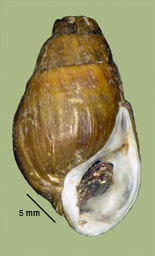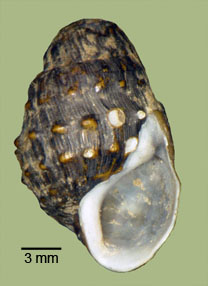> Habitat & Distribution
Lithasia verrucosa was (at least historically) the broadest-ranging species in its genus, being found through the lower portions of the Ohio River and its major tributaries, and in some Arkansas Rivers as well, plus most of the major rivers of the Tennessee drainage (Goodrich 1940). Tiemann et al. (2013) reported a population in the main Mississippi River.
The Ohio River population still seems viable these latter days, as well as that of the Wabash. But L. verrucosa is very spotty in East Tennessee, populations being found only in the lower reaches of the Nolichucky and French Broad Rivers, of which we are aware. The main Tennessee River population is patchy from the tailwaters of Nickajack Dam (below Chattanooga) to the tailwaters of Pickwick Dam (near Savannah), plus several major tributaries: the Elk River, Cypress Creek, and Bear Creek. Lithasia verrucosa is another of the pleurocerids apparently specialized on rocky shoals in larger rivers, a habitat type that nearly disappeared from this region in the 20th century. FWGNA incidence rank I-4.
> Ecology & Life History
Pleurocerids are heavily-shelled, conspicuous freshwater gastropods, typically inhabiting firm substrates in shallow waters. Males are aphallic; females can be distinguished by an egg laying groove on the right side of their foot. Most populations are perennial and iteroparous, typically requiring more than a year to mature and living several years (Life cycle Hi of Dillon 2000: 156-162). Eggs are affixed to hard substrates singly or in small clusters from spring to midsummer. Pleurocerids are generalized grazers, and where present in high density can have significant effects on energy flow in streams (Dillon 2000: 86-91).
> Taxonomy & Systematics
As is true in the Pleuroceridae generally, specific distinctions among the (approximately ten) currently-recognized species of Lithasia rest entirely upon characters of the shell. Intergradation among these nominal species is a well-documented phenomenon (Goodrich 1934, 1941, Minton 2002, Minton et al. 2008). On morphological criteria, the distinction between Lithasia verrucosa and L. lima is not clear, nor is L. verrucosa distinct from L. salebrosa in some situations. Most of the individual Lithasia we have examined from the Nolichucky and French Broad Rivers are bear tuberculate shells, for example, as is typical of L. verrucosa (above). But mixed with the French Broad population we occasionally find rare individuals bearing shells so smooth as to match the description of L. salebrosa (below).
Minton & Lydeard (2003) sampled ten Lithasia populations (24 individuals) identified under three specific nomina - verrucosa (6 populations), lima (2 populations) and salebrosa (2 populations). All these populations were genetically indistinguishable. These results, together with morphological observations such as outlined above, lead us to suggest that L. salebrosa (Conrad 1834) and L. lima (Conrad 1834) be considered junior synonyms of L. verrucosa (Raf. 1820).
Uncertainty regarding the identity of Rafinesque's nomen "verrucosa" played a central role a long-running controversy regarding the higher taxonomy of the Pleuroceridae, only ultimately resolved by the ICZN (Melville 1981). See my essay of 10Nov10 from the link below for more.
> Maps and Supplementary Resources
- Lithasia distribution in drainages of The Ohio (2019)
- Lithasia distribution in the Tennessee/Cumberland (2022)
- Smooth-form L.
verrucosa from the French Broad River, matching the
general description of
Lithasia salebrosa.

> Essays
- The early history of Rafinesque's nomen "verrucosa" figured in my FWGNA post of 10Nov10, Joe Morrison and the Great Pleurocera Controversy.
> References
Dillon, R. T., Jr. (1989)
Karyotypic evolution in pleurocerid snails: I. Genomic DNA estimated by
flow cytometry. Malacologia, 31: 197-203.
Dillon, R. T., Jr. (2000)
The Ecology of Freshwater Molluscs. Cambridge, Cambridge University
Press. 509 pp.
Goodrich, C. (1934)
Studies of the gastropod family Pleuroceridae - I. Occas.
Pprs. Mus. Zool. Univ. Mich. 286: 1 - 17.
Goodrich, C. (1940)
The Pleuroceridae of the Ohio River drainage system. Occas.
Pprs. Mus. Zool. Univ. Mich., 417: 1-21.
Goodrich, C. (1941)
Studies of the gastropod family Pleuroceridae VIII. Occas.
Pprs. Mus. Zool. Univ. Mich. 447: 1 - 13.
Melville, R. V. (1981)
Opinion 1195. Pleurocera
Rafinesque 1818 (Gastropoda): The type species is Pleurocerus acutus
Rafinesque in Blainville, 1824. Bulletin of Zoological Nomenclature 38:
259-265.
Minton, R. L. (2002)
A cladistic analysis of Lithasia
(Gastropoda: Pleuroceridae) using morphological characters.
The Nautilus 116: 39-49.
Minton, R. L. &
C. Lydeard (2003) Phylogeny, taxonomy, genetics, and
global heritage ranks of an imperiled, freshwater snail genus Lithasia
(Pleuroceridae) Molecular Ecology 12: 75-87.
Minton, R. L., A. P.
Norwood & D. M. Hayes (2008) Quantifying
phenotypic gradients in freshwater snails: a case study in Lithasia
(Gastropoda: Pleuroceridae) Hydrobiologia 605: 173-182.
Tiemann, J. S., W. R.
Posey, K. S. Cummings, K. J. Irwin, and B. Turner (2013)
First occurrences of Lithasia
armigera and Lithasia
verrucosa (Gastropoda: Pleuroceridae) in the Mississippi
River. Southeastern Naturalist 12: N35 - N39.








